The next-gen MacBook Pro with Retina Display Review
by Anand Lal Shimpi on June 23, 2012 4:14 AM EST- Posted in
- Mac
- Apple
- MacBook Pro
- Laptops
- Notebooks
Battery Life
For much of the past year I haven’t been pleased with just how good Apple’s caching has become both on OS X and iOS. Aggressively caching our test web pages produces artificially inflated battery life numbers and that’s no fun for anyone. I’m happy to say that I’ve fixed that problem with our OS X battery life tests.
The suite is completely redone although conceptually it’s quite similar to what I’ve run in the past. I have three separate workloads: light, medium and heavy, each one representing a different stress level on the machine and all three giving you a decent idea of the dynamic range of battery life you can expect from one of these notebooks. All three tests are run with the displays set to 100 nits (a little above the halfway brightness point on most MacBook Pros).
The light and medium suites are inherently related - they use the same workload and simply vary the aggressiveness of that workload. The light test hits four different websites every minute, pausing for nearly the entire time to simulate reading time. Flash is enabled and present on three of the sites. The long pause time between page loads is what really makes this a light test. Web browsing may be the medium for the test but if all you’re doing is typing, watching Twitter update and maybe lazily doing some other content consumption this is a good representation of the battery life you’ll see. It’s a great way of estimating battery life if you’re going to be using your notebook as a glorified typewriter (likely a conservative estimate for that usage model).
The medium test hits the same webpages (Flash and all) but far more aggressively. Here there’s less than 10 seconds of reading time before going onto the next page. It sounds like a small change but the impact on battery life is tremendous.
Both the light and medium tests are run in their default state with processor graphics enabled, as well as with the discrete GPU forced on. I run with the dGPU on as well because it’s far too often that a single application open in the background will fire up the dGPU and contribute to draining your battery. The goal here is to deliver useful numbers after all.
The final test is very similar to our old heavy multitasking battery life tests, but with some updates. Here I’m downloading large files at a constant 1MB/s from a dedicated server, while playing back a looped 1080p H.264 movie (the Skyfall trailer) all while running the medium battery life test. The end result is a workload that gives you a good idea of what a heavy multitasking usage model will do in terms of battery life. I’ve found that OS X tends to fire up the dGPU anyway while running this workload so I saw no reason to run a separate set of numbers for processor and discrete graphics.
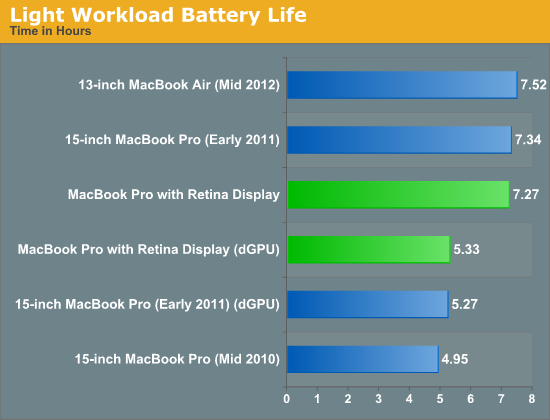
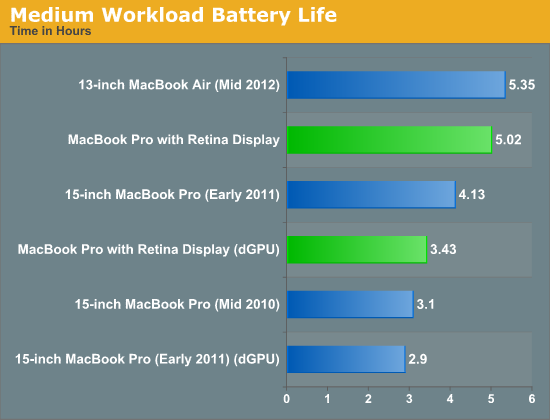
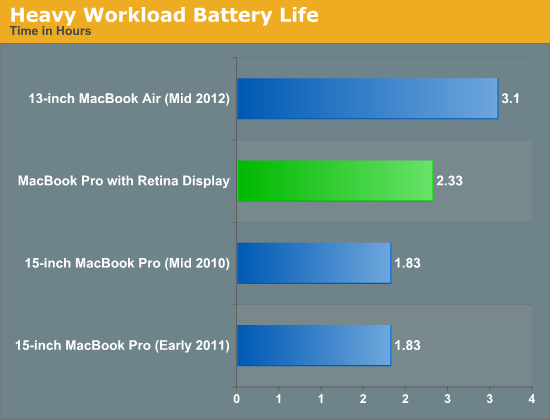
Overall the rMBP pretty much behaves as expected. Apple claims up to 7 hours of battery life and using our light workload we see a bit over that. Fire up the dGPU and even a light workload will get cut down to around 5.5 hours. Moderate usage will drop battery life to around 5 hours, and if you fire up the dGPU you’ll see that cut down to 3.5. The heavy multitaskers in the audience will see a bit above 2 hours out of a single charge. Note that all of these numbers are at 100 nits, drive the 2880 x 1800 panel at its full brightness and you can expect a tangible reduction in battery life.
The rMBP’s integrated 95Wh battery is ginormous by today’s standards, but it’s really necessary to drive both the silicon and that impressive panel. Subjectively I did find the rMBP lasted longer than last year’s MacBook Pro, despite the similar max battery life ratings. My experiences were echoed by the results in our tests.
I suspect most users will see around 5 hours of battery life out of the system compared to a bit under 4 hours out of last year’s machine. At minimum brightness, typing a long document (similar to what I’m doing right now) you can significantly exceed Apple’s 7 hour estimate. As always it really depends on usage model. Professional users doing a lot of photo and video editing aren’t going to see anywhere near the max battery life, while the writers and general users will be quite happy.
One trick to maximizing battery life on light or moderate workloads is to keep an eye on what the discrete GPU is doing. I still find that OS X will wake up the discrete GPU far too frequently, even when in my opinion its services aren’t needed. As always I turn to Cody Krieger’s excellent gfxCardStatus app for keeping an eye on which GPU is driving the panel. The app has been updated and is now fully compatible with the rMBP.


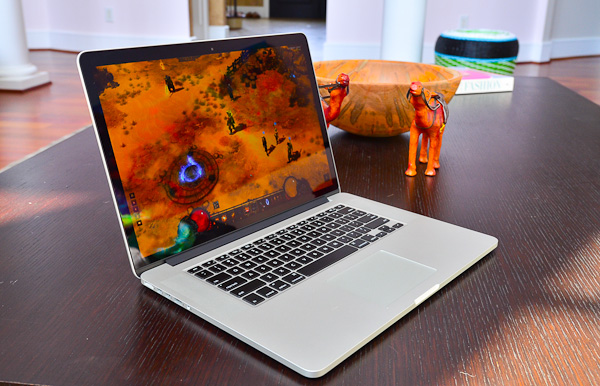
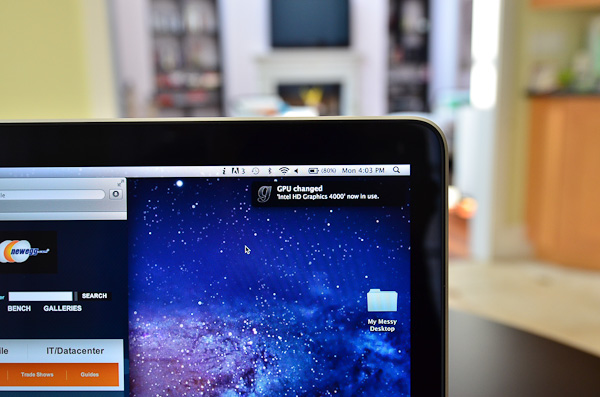








471 Comments
View All Comments
KoolAidMan1 - Friday, July 6, 2012 - link
Please, MBAs have always had good CPUs, and what is happening now with Ivy Bridge is nothing new.I get it, in your world, Ivy Bridge is magically low when it is in an Apple laptop, got it.
Your argument is undermined because you have none, and your name calling only nails down how desperate you are.
Spunjji - Tuesday, June 26, 2012 - link
Idiot.KoolAidMan1 - Saturday, June 23, 2012 - link
16:9 display, who cares?Ohhmaagawd - Saturday, June 23, 2012 - link
"Rubbish, there are plenty of other companies who are far more innovative than Apple whose machines look basic in comparison - Sony's older Z series had a very high resolution 13.1in 1080p screen, blu-ray writer, quad SSDs in RAID 0, integrated and discrete graphics card and the fastest of te dual core i7's while still smaller and lighter than Apple's 13in machines and that was a couple of years ago. Apple aren't even close to touching most of its technology and probably never will."how is any of that innovative? Quad SSDs/RAID 0 is pretty cool - i'll get them that. But other than that? I looked at these things. They have freaking VGA ports. They look like decent machines with above average designs, but that's about it.
So what's innovative about apple laptops? mag safe. glass trackpads that don't suck (no one else makes a useable trackpad IMO). unibody aluminum case. magnetic latch system is unmatched. event the little prongs on the small power supply are nicer than anything else I've see. ability to sleep and wake up :) (I still haven't used a Windows laptop that consistently can do this). backlit keyboard. thunderbolt connector (first on mac) allows you to realistically use only two connections - thunderbolt for display/data and power. first to have ultra thin laptops (Air). and now the retina display.
OCedHrt - Sunday, June 24, 2012 - link
As others answered, the VGA ports is because many projects use VGA still and the target is upper management and enthusiasts. This comes from Japan's management hierarchy. Except Sony to refresh with a dongle of some kind in the future now that Apple doesn't have an exclusive on thunderbolt.Ohhmaagawd - Sunday, June 24, 2012 - link
Thunderbolt was never mac exclusive: http://www.pcmag.com/article2/0,2817,2380954,00.as...And any company could have used display port as apple did previously.
Answer to the projector prob is a dongle (that's what I do). Or buy a decent projector. Or better yet - just get an HDTV.
Spunjji - Tuesday, June 26, 2012 - link
Oh sure, buy a decent projector for every client you're visiting on your business trips. Problem solved!Dumbass.
vegemeister - Monday, July 2, 2012 - link
>They have freaking VGA ports.Er, how is this a problem?
kmmatney - Sunday, June 24, 2012 - link
Too bad Sony doesn't have the balls to make a 16:10 display.ramb0 - Monday, June 25, 2012 - link
yeah sure. The Finger Swipe security feature is probably the best innovation outside of Apple. I mean, that feature totally took off. It's amazing Apple hasn't caught on yet. I guess they're too busy innovating features that people actually give a fuck about. And by "people" i'm talking about the majority, not little nit pick wankers like you.